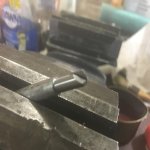A couple of inquiries first:
1. Are the "grooves" really as bad as they appear? By their very nature borescopes tend to make imperfections in the bore appear worse than they are.
2. Are the "grooves" lengthwise in the chamber (it sounds like they are).
By themselves the grooves should not greatly impede the extraction of the cases if they are lengthwise in the chamber, especially if the grooves are at the case head end of the chamber rather than at the projectile end. Remember that some rifles (e.g. certain HKs) actually have flutes (which technically are just deep grooves) machined into their chambers and they have no issue with extraction.
The "piles" of metal you mention are what could cause problems as they could create irregular spots that the fired cases might hang up on. However, if they can be removed either by polishing or, if extreme, reaming so that they are not creating a dimensional variation in the chamber I think the gun will be shootable and extraction will be reliable.
If this was a centrefire rifle and you wanted to reload the cases the grooves that will probably result from the expanding cases filling the chamber scratches might make them unsuitable for reloading but that problem is a non-starter in a rimfire rifle. I have resized once fired .223 cases out of an HK and they worked fine as there was only one set of flute grooves and the rounds were refired in a non-fluted chamber gun.
1. Are the "grooves" really as bad as they appear? By their very nature borescopes tend to make imperfections in the bore appear worse than they are.
2. Are the "grooves" lengthwise in the chamber (it sounds like they are).
By themselves the grooves should not greatly impede the extraction of the cases if they are lengthwise in the chamber, especially if the grooves are at the case head end of the chamber rather than at the projectile end. Remember that some rifles (e.g. certain HKs) actually have flutes (which technically are just deep grooves) machined into their chambers and they have no issue with extraction.
The "piles" of metal you mention are what could cause problems as they could create irregular spots that the fired cases might hang up on. However, if they can be removed either by polishing or, if extreme, reaming so that they are not creating a dimensional variation in the chamber I think the gun will be shootable and extraction will be reliable.
If this was a centrefire rifle and you wanted to reload the cases the grooves that will probably result from the expanding cases filling the chamber scratches might make them unsuitable for reloading but that problem is a non-starter in a rimfire rifle. I have resized once fired .223 cases out of an HK and they worked fine as there was only one set of flute grooves and the rounds were refired in a non-fluted chamber gun.








































































